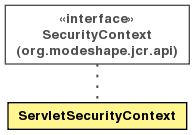 org.modeshape.web.jcr.ServletSecurityContext
org.modeshape.web.jcr.ServletSecurityContext
|
||||||||||
| PREV CLASS NEXT CLASS | FRAMES NO FRAMES | |||||||||
| SUMMARY: NESTED | FIELD | CONSTR | METHOD | DETAIL: FIELD | CONSTR | METHOD | |||||||||
java.lang.Objectorg.modeshape.web.jcr.ServletSecurityContext
public class ServletSecurityContext

Servlet-based security context that assumes servlet-based authentication and provides authorization
through the servlet role-checking mechanism.
This security context is really only valid for the life of the servlet request and should
only be used to support longer-lasting session scopes with great care. *
| Constructor Summary | |
|---|---|
ServletSecurityContext(javax.servlet.http.HttpServletRequest request)
Create a ServletSecurityContext with the supplied servlet information. |
|
| Method Summary | |
|---|---|
String |
getUserName()
Returns the authenticated user's name |
boolean |
hasRole(String roleName)
Returns whether the authenticated user has the given role. |
void |
logout()
Logs the user out of the authentication mechanism. |
| Methods inherited from class java.lang.Object |
|---|
clone, equals, finalize, getClass, hashCode, notify, notifyAll, toString, wait, wait, wait |
| Constructor Detail |
|---|
public ServletSecurityContext(javax.servlet.http.HttpServletRequest request)
ServletSecurityContext with the supplied servlet information.
request - the servlet request; may not be null| Method Detail |
|---|
public final String getUserName()
getUserName in interface SecurityContextSecurityContext.getUserName()public final boolean hasRole(String roleName)
hasRole in interface SecurityContextroleName - the name of the role to check
SecurityContext.hasRole(String)public void logout()
For some authentication mechanisms, this will be implemented as a no-op.
logout in interface SecurityContextSecurityContext.logout()
|
||||||||||
| PREV CLASS NEXT CLASS | FRAMES NO FRAMES | |||||||||
| SUMMARY: NESTED | FIELD | CONSTR | METHOD | DETAIL: FIELD | CONSTR | METHOD | |||||||||